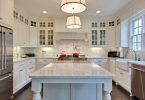 Getting your first house can be very exciting, as you finally get to do all the things you wanted to do in your family home but your parents wouldn’t let you. The trouble is that with so many possibilities of what to do, people get scared they will do the wrong thing. Having a process will help you make choices that you will like for a while to come.
Getting your first house can be very exciting, as you finally get to do all the things you wanted to do in your family home but your parents wouldn’t let you. The trouble is that with so many possibilities of what to do, people get scared they will do the wrong thing. Having a process will help you make choices that you will like for a while to come.
Colours:
- Divide the house into area, the public space and the rooms.
- The public spaces are all the hallways and the entrance to the house. It is wise to choose a good neutral colour for this area. Right now the popular neutral colour is in the warm grey tones, but choose a colour that YOU are comfortable with. It is common to consider what others will say or how they will judge you based on your choices but keep reminding yourself – this home is for ME!
- Every other colour in the house will have to work with this colour which is why it is good to choose a neutral.
- Next choose a colour for ceilings in a warm white, there is lots of blue in the whites that builders often paint. I like Cloud White from Benjamin Moore as a ceiling colour.
- Next choose a slightly warmer white for all of the trim in the house. Ceilings and trim should stay consistent throughout the house so that we have a common element from room to room giving us the feeling that we are always in the same house regardless of the wall colour.
- Now choose wall colours for each room. Remember to look at the colour chips in the room as the quality of light will affect the colour. Look at the colour perpendicular to the floor as that is how the light will hit the walls. Every colour doesn’t have to coordinate with every other colour unless you will see the two rooms at one time. The kitchen and the second floor bedroom don’t have to work together but they do have to work with the public colour which will indicate the palette of the house.
- It will take a couple of coats per room to cover the walls well. If you are concerned about getting enough paint, measure the rooms (length by width and ceiling heights) and take the measurement to the paint store and they will help you out.
Form follows function:
- How are you going to use each room?
- Will the living room be for television or will it be a place to spend time with friends. Will the bedrooms be offices or bedrooms, will the basement be for storage or a place to watch movies etc.
- The function of the room will help you decide what furniture you will require.
- When you go out looking for furniture and find something that you like, get the dimensions before you buy. Go home and tape out the dimensions on the floor of your home. Sometimes things that look reasonable in a large showroom are actually huge when you get them back to your own home.
- If all the furniture fits in the room with enough space to walk around then it is likely a good scale for your home.
- Remember the spacing around the furnishings. You need about 32 to 36 inches for a walk way around furniture. You need about 14 to 18 inches in front of the sofa to the coffee table. Dining chairs should have 18 to 20 inches behind them when pulled out, for easy passage
- In a small space, select furniture that sits high enough off the floor that you can see the flooring material under the furniture.
Prioritize:
- If funds are bit tight when you are working on the house, select the rooms that are essential to living and work of them first: the bedroom, the kitchen and the bathrooms.
- Leave the other rooms empty until you can afford to get what you want to have. Just putting “something” in the other rooms tends to quell your desire to save to be able to outfit them the way that you would like.
Stand back and evaluate:
- What you have selected as paint colour and furniture for the house, it will be a good indicator of the style you are attracted to.
- Accessories should stay in that theme
- Wall art is likely the most important accessory to make a house feel like a home. “ Your style” indicates the kind of frames you select but the art can be whatever speaks to you.
- Accessories should also be selected based on the impact they have on you when you are looking
- Before you shop, identify the need. “ a small vase on the side table would be lovely” THEN go looking for the right thing.
- You waste money by a selecting product and then trying to find a place to put it. Have the need prompt the shopping , not the shopping prompt the need for a space.
The following two tabs change content below.


Canadian Home Trends' National Design Editor, Glen Peloso forged into the world of design 20 years ago after completing his Masters degree in Fine Art. As Principal of Grafus Design Co., he has worked in residential, hospitality and commercial spaces for clients in several countries and has successfully designed over 300 projects in that time. TV Celebrity Designer and Canadian Home Trends National Design Contributor, Glen is also recognized as a design expert on The Marilyn Denis Show and from his past work as a host/designer of the internationally popular television shows Foodnetwork/HGTV`s Restaurant Makeover, and W networks ‘Take this House and Sell it’, and “Slice Network” show, Renovate my Wardrobe.
Latest posts by Glen Peloso (see all)
- Glen’s Kitchen Must-Haves - December 3, 2025
- 2023 Trends with Designer Glen Peloso - December 3, 2025
- Bathroom Design Tips - December 3, 2025







Thanks Glen!!
I’m often tasks in helping my clients decorate their new homes and I love your ideas on colour and decor. I will be sure to incorporate some of your suggestions.
Thanks again.